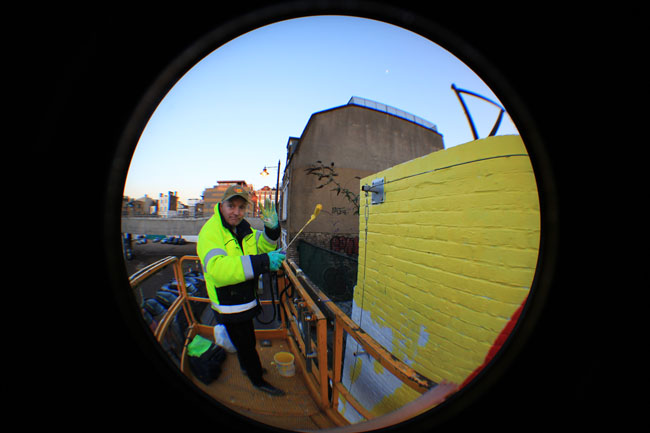
Thierry Noir painting The Village Underground Wall (Feb 2013)
Thierry Noir was born in 1958 in Lyon, France, and came to Berlin in January 1982. He found a place to live close to the Berlin Wall. In April 1984, Noir began to paint the Berlin Wall in order to perform one real revolutionary act: to paint the Berlin wall, to transform it, to make it ridiculous, and to help destroy it. When the Wall fell in 1989 his paintings became a symbol of new-found freedom across Germany. Noir spent a week in London painting his iconic imagery around the streets of Shoreditch.
Why did you move to Berlin in 1982?
I moved to Berlin for one simple reason – because I couldn’t find my way in France. I was fired from every job I started. After a while I said to myself, I have to change something in my life, because if I continue like this I’m going directly into a dead end. I didn’t want to be unemployed. So I thought to myself, I have to change something radically in my life. At that time I had heard a lot about West Berlin, about the music. There were a lot of new wave groups. A lot of people had to live in squats because there were no flats. The new mayor of West Berlin said, “If I am elected, I promise I will clean all the squats from Berlin”. So he got elected in June ’81, and from that point on there was a big battle in West Berlin about housing, with a lot of police and violence. It was in the news everyday in France, so I said to myself let’s go there, let’s see what’s happened. So I started from nothing, with only two small suitcases. I came with an address, but after a few days some guys said to me you have to find something else. I was really on the street, with only my two suitcases, and I started from zero to live in Berlin.
Were you interested in art before you moved to Berlin?
Not really. I started to remark in West Berlin that everybody I met was an artist. So I thought, what a great city – I never met one artist in 20 years in Lyon, and now in one week I have already met 20 artists. I said to myself lets continue in this way; somebody asked me ‘Are you and artist?’ and I said ‘yes’.
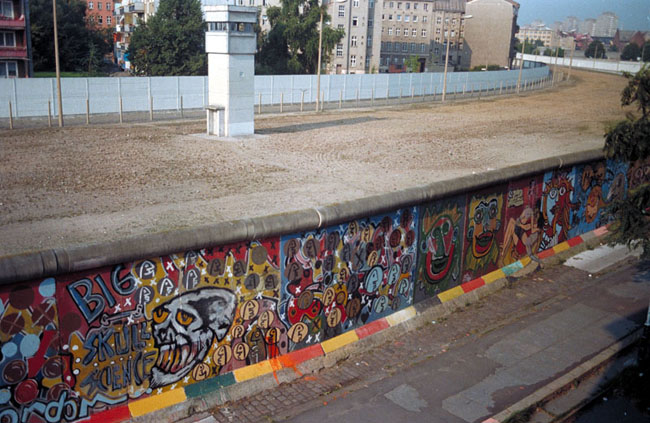
The view from Noir’s bathroom in the 1980s (Photo: Thierry Noir)
What was it like living so close to the wall?
I found this house and lived there for 20 years. It was a youth centre – it’s still a youth centre. It was a former hospital but was abandoned because it was so close to the wall. The city of Berlin decided to make a modern, new hospital far from the wall. So in 1971, this hospital was still empty, and a lot of young people decided to occupy it and live there. There was a big battle with the police – one part of this big hospital was still a squat, and in 1978 it was legalised as a youth centre. When I came in 1982, it was already a youth centre, very close to the wall, and it was very special to live there. It was absolutely not like Lou Reed said in his song, ‘It was so nice, it was paradise…Dubonnet on ice’. It was really aggressive to live so close to the wall. Nothing happened really, but at the same time a lot happened, because this melancholic life was very aggressive against the brain. I thought I was getting a little bit crazy with this life by the wall, and 2 years after, in 1984, I decided spontaneously to start to make something on the wall. I got thousands of questions, everyone wanted to know something about this, because it was new – there were no big paintings on the wall, and everything which is new is a little bit disturbing. Everyone wanted to know at first, ‘Who pays you?’ That was the first question.
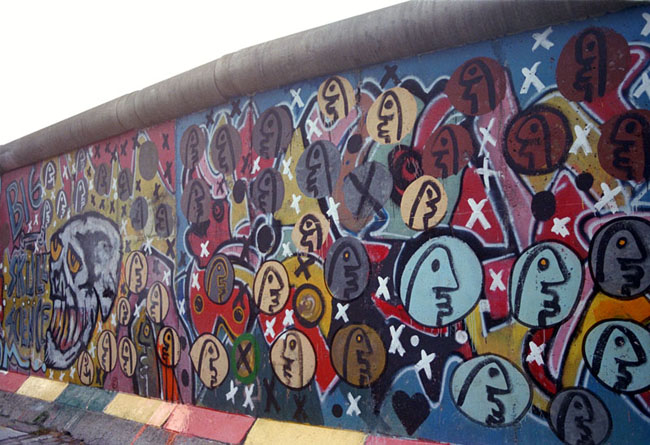
(Photo: Thierry Noir)
Why was it important for you to paint the wall?
It was like a delivery, to show that I am stronger than the wall; I can paint it. I had no idea about the political aspect of the wall, because at school in France we never learned anything about the wall, about that system of West Berlin surrounded by a wall, with East Germany inside. I had no idea what it was all about. Some people were very aggressive because they thought I was paid to make the wall beautiful. I had to stop sometimes and answer them, saying, “No you cant make the wall beautiful because it is a deadly border, and even if you put thousands of kilos of colours on the wall, this wall will never be beautiful.” It was important to repeat this all the time, because it was very emotional at the wall.
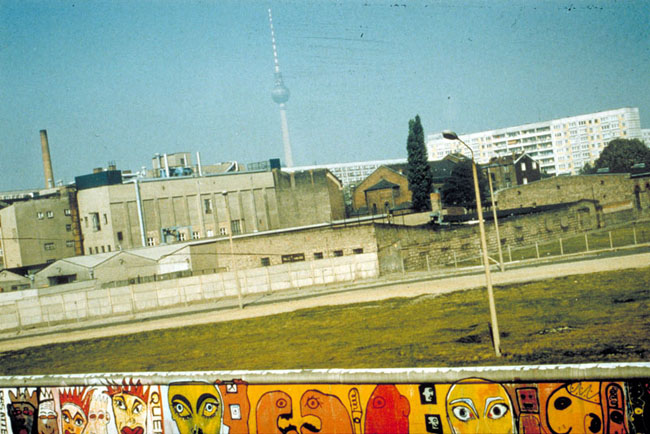
Another view from Thierry’s window over East Berlin (Photo: Thierry Noir)
So, did people respond badly to you painting the wall at the beginning?
Yes, they insulted me and treated me like I was a spy from France. It was like this at the very beginning until 1987, when Wim Wendors started to make his film ‘Wings of Desire’. It was an international success, and the Berliners started to think about what the paintings on the wall are all about, and then suddenly it was another time. In Russia, Gorbachev wanted to change the system, and even in the GDR it was different. Some new guys in the GDR wanted to change things, so it was a new time.
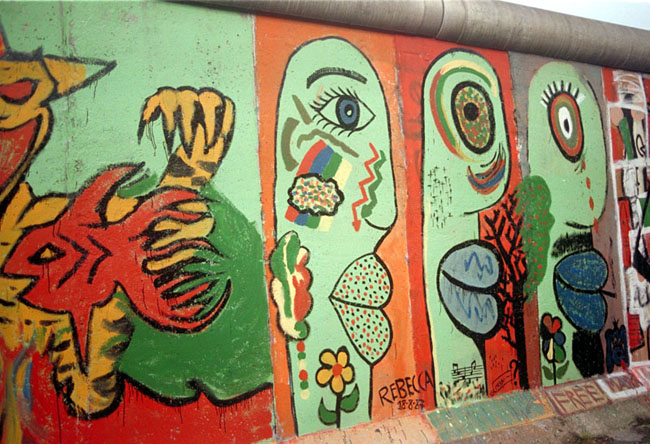
(Photo: Thierry Noir)
Did you see it as a revolutionary act?
It was a political act to paint the wall – even if you made pee-pee on the wall it was political (laughs). It was forbidden to paint the wall, so in a way it was a revolutionary act. At the same time, it was a mutation of the culture in Berlin, because it was impossible to find another place in Europe with kilometres of painting in the middle of the city. It was bizarre to see, like in Potsdam when suddenly the full moon would light the wall, and it would come up like a 3D object. It was something special, that wall. In another way it was a mutation of nature. The wall was 45 kilometres long between East and West Berlin and it was like a big camp for rabbits. There were thousands of rabbits between those 2 walls. They were very clever because they were sleeping in the East and then eating in the West, some leftover kebab and pizza left by the tourists, like at Potsdamer Platz.
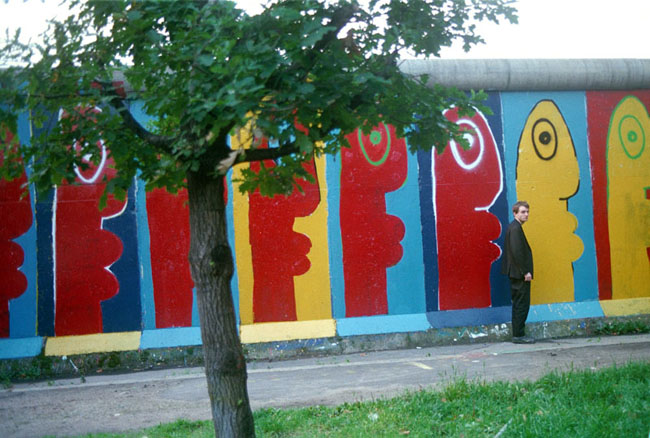
Noir at the Wall in the 1980s (Photo: Thierry Noir)
Why did you paint in that particular style?
That style of painting came because I couldn’t finish my painting because of thousands of questions – everybody wanted to know something. I said to myself, I speak longer than I paint, so I cant finish what I want to do. So I started to develop a style of painting where it is possible to paint and talk at the same time!
Did your speed respond to the danger?
There was danger in certain places, like for example Checkpoint Charlie, because it was well guarded, and it was near certain places where there was a small door in the concrete – in those places it was dangerous to paint. But near our youth centre, it was okay because we knew the border. The wall was not a border, but was 5 metres behind the real East-West border. It was important to know where this line was, as it was dangerous even just to run over those 5 metres.
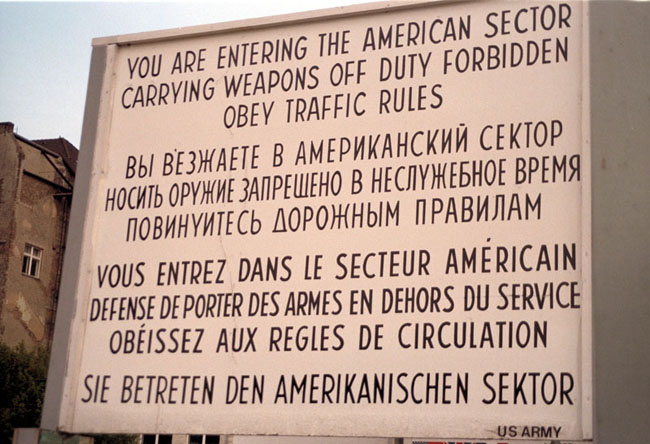
(Photo: Thierry Noir)
What do you think of some current street art which takes much longer to paint, with lots of intricate detail, i.e. artists such as Phlegm or ROA. Do you think it needs to be spontaneous to have the same effect?
You can’t compare this Berlin wall art with this art in London; it was different. The Berlin Wall was not an art project, but a deadly border. It very often happened to me that I made a big mural in the afternoon and one stupid ‘Michael’ put his name in front of my nice painting, and I said to myself, ‘Fuck you!’ I was upset, and then I thought what can I do? Shall I sleep in front of the wall? So I started to adapt to this situation in my painting. It’s often legal to paint now, so its okay if it’s complicated. But at that time it was impossible to do complicated things.
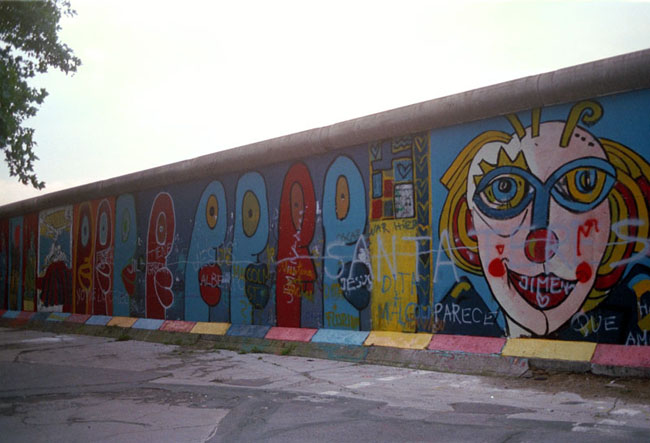
(Photo: Thierry Noir)
Are the designs symbolic?
Yes, they are now in a lot of countries a symbol of the new freedom in Europe. There are pieces of the Berlin wall almost everywhere now, in Los Angeles, New York, Yokohama. It is a symbol of the new freedom that is not coming from the sky, freedom that is not given to you, but that you have to fight for. If you look now on Wikipedia, you will see new walls all around the world. The speech of the new wall-makers is ‘do not compare these with the Berlin wall, they are nothing to do with it’, but I think, of course it’s the same, a wall is a wall and the reason is different but the wall is still there, and one day this wall also will disappear.
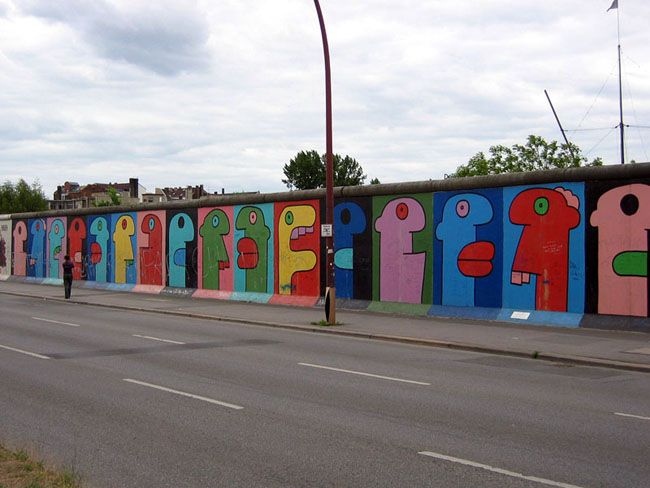
Noir’s segment of The East Side Gallery in Berlin (Photo: Thierry Noir)
Why do you use such bright vivid colours?
This is my way to paint; I don’t know why I do it like this!
Do you have any influences?
Oh yes I have influences. The weather for example, is very important, if its raining or not, if its winter or summer (laughs). And influences from everywhere – television, comics, the Internet, former painters.

Noir’s iconic imagery at the East Side Gallery in Berlin (Photo: Thierry Noir)
You said that your aim was to make the wall ridiculous in order to destroy it. Why use this form of political dissent rather than an overt political slogan?
There were already a lot of words on the wall. There were 3 categories – against the US army, every 5 metres ‘US go home’; a lot of racist comments, ‘Turkish go out’, and a third category were funny slogans and personal words. So I thought to myself, this is enough, I don’t want to do any more writing, so I did what I could do, and that is to paint.
You also said that ‘The wall created in Berlin an atmosphere of urgency, which gave artists the feeling of trying to survive.’ Do you think that in that way the wall acted as a catalyst for art? Were other artists responding to the wall in a less direct way?
The point is that the German artists never painted the wall…there was a kind of taboo I think. The German artists never wanted to paint, and also the normal population of Germany came once or twice per year to the wall and that was it. Maybe it was because I was a foreigner that I started to paint the wall. I heard that some people even made detours with cars not to drive along it…there was a very special atmosphere. Maybe because it was a shame, I don’t know. This wall was very strong for a German, stronger than for me because I came from France and I did not have this pressure.
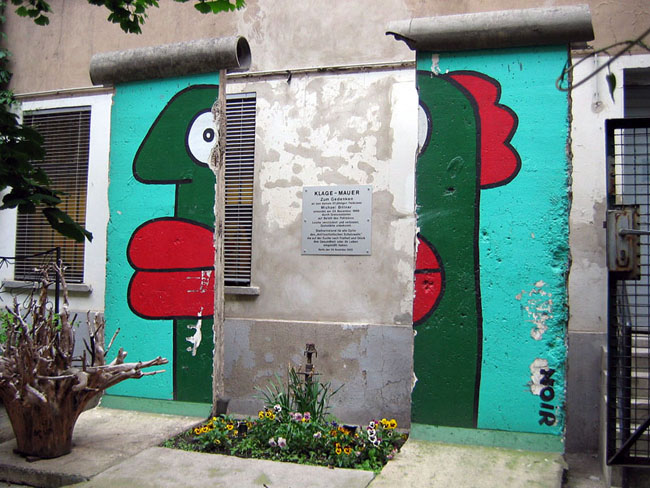
Memorial in Berlin featuring Noir’s artwork (Photo: Thierry Noir)
In your opinion, how has street art changed? Is it still a revolutionary act?
Street art is new because at that time it was called graffiti. Now it is street art and now it is also commercial. I see in Berlin, every year for fashion week, Levis has a big event for street art, so I think the commercial aspect of street art is strong now. It is also legal to paint on the street. When I started it was not, there was not even any graffiti at all in Berlin at that time. There was some writing on the wall, but on the street there was almost nothing. The street art movement is very strong now, not only in London but everywhere. You can see graffiti in the Caribbean now. Even in China – a TV team from Hong Kong came to Berlin and we were talking about graffiti in China, which is very new. It started in 2008 with the Olympic Games in Beijing. At that time, to prepare for the Olympic Games, a lot of old houses were destroyed. People came in the morning and told people, ‘Okay, you have one hour to go’, and then they destroyed everything. After that people start to put big writing, graffiti on those houses, saying ‘stop’ in Chinese letters to protect them.
You were talking about commercialisation. I know that Peugeot and Mazda have used your designs. What do you think of them using your designs as symbolic of freedom?
It speaks immediately to the young generations. My work being used for advertising is the price to pay. Lawyers have to say if it is alright or not…I don’t want to think about it much more after that.
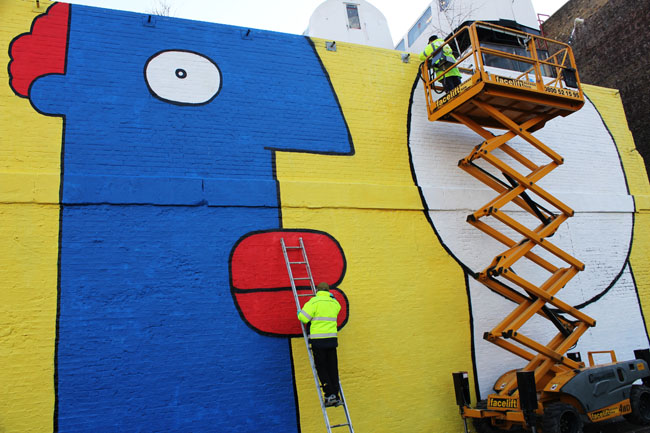
Noir and Stik painting The Village Underground Wall (Feb 2013)
What do you think about current politically charged street art, like that of Banksy? Do you think street art can still have a political message or has the proliferation of street art in recent years undermined its ability to do so?
Of course, street art is political. Like I said before, in China, and also in Chile, in Santiago. When Pinochet took the government in 1973, his army broke the hands of painters so they could not paint anymore. I went to Santiago in 2009 and there are now a lot of paintings on the street that are very political.
How did your experience of painting the wall change after it fell? Tell us about the East Side Gallery.
The East Side Gallery is completely different because it was done in 1990 after the fall of the wall and it was not dangerous to paint. It was not a border anymore, so you can’t compare it. It is now more an homage to younger generations, to say look at the wall, the wall was not an art project; please do not repeat the mistakes of your parents.
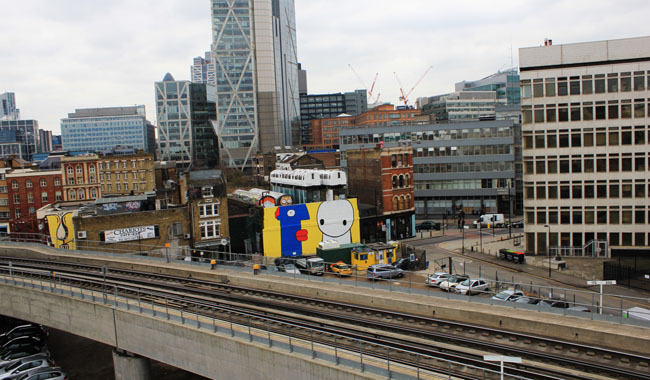
The completed collaboration between Nour and Stik in Shoreditch, East London
What was it like to paint the east side?
It was very special to be on the other side and to paint the wall. The East Side Gallery is a large avenue which was at that time the way from the airport to the centre of East Berlin, and the East Side Gallery was also made like this to tell those VIPs that the wall will stay for a long time; it is very strong. So now it’s very special to walk along the wall, with thousands and thousands of people every day who come from all over the world. Everybody wants to write something on the wall, even if its not allowed. But that’s okay.
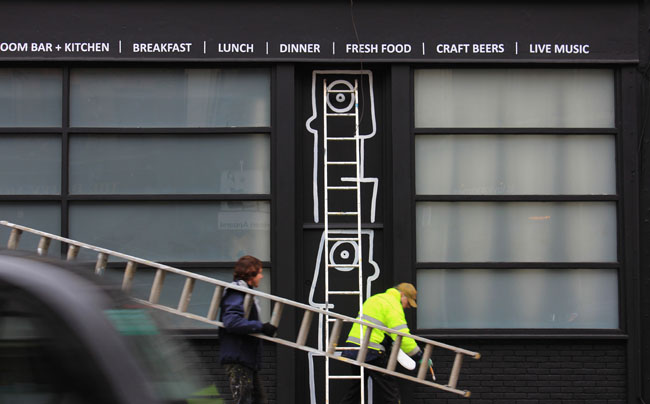
Noir painting in Shoreditch (Feb 2013)
Tell us about the time when Keith Haring painted over your murals on the wall.
Keith Haring was invited at the end of October 1986 by the Checkpoint Charlie museum to paint 100 metres of the Berlin Wall. The thing was, I had painted this spot of the wall with another French painter called Christophe Bouchet. We had wanted to paint 100 statues of liberty at Checkpoint Charlie for the celebration in July 1986 of the 100-year anniversary of the Statue of Liberty in New York. We did not have enough money for this though so we painted only 44 statues (laughs). But it was something! To paint at Checkpoint Charlie was very rough, because that spot was very guarded, by soldiers, by Stasi, by checkpoint police. It was not Haring’s fault because the Checkpoint Charlie museum had organised that five people would prepare the wall for him in the early hours, and when Keith Haring came at 11 o’clock it was already all yellow, but it was very bad quality so you could see our strong statues of liberty behind. He told me after he had wanted to stop, but it was not possible because a lot of press and television was there, so he had to start to paint over our murals. But it was okay!
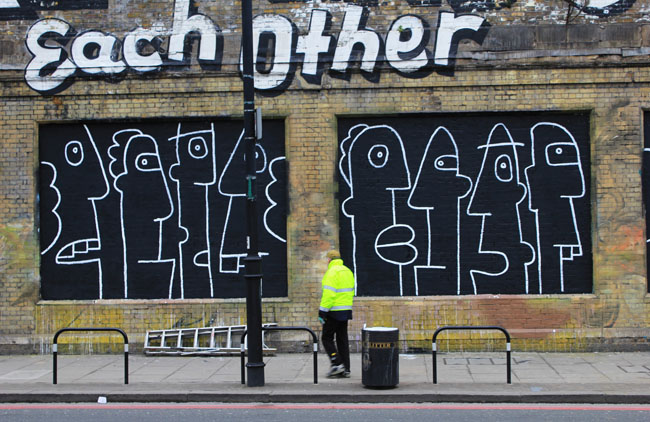
Another wall by Noir in Shoreditch (Feb 2013)
Do you still paint walls in Berlin?
Yes, I have painted maybe five times now the East Side Gallery again and again, because it is very damaged by thousands of people every day. Everybody writes their name on the wall, from all over the world. When I go back to Berlin I have to repaint three big heads I have done in Schöneberg.
How do people respond to you painting now?
Now I am a classic. It’s completely different than when I started to paint. People don’t insult me anymore!
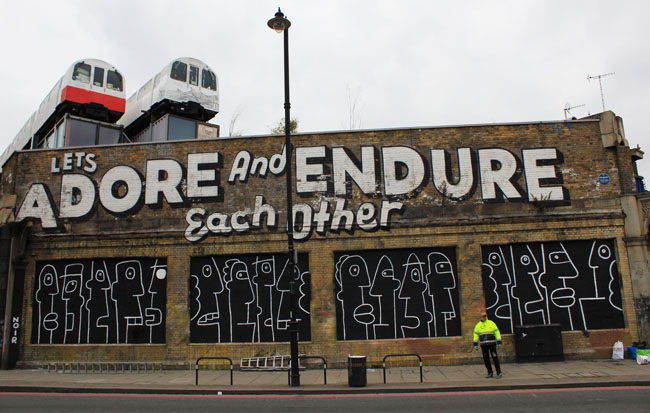
Noir below Steve ‘ESPO’ Powers at The Village Underground
What street artists in Berlin do you like?
It’s hard to tell, there are a lot of street artists. I don’t know all the names. I like those two big paintings by two brothers from Brazil…Os Gemeos.
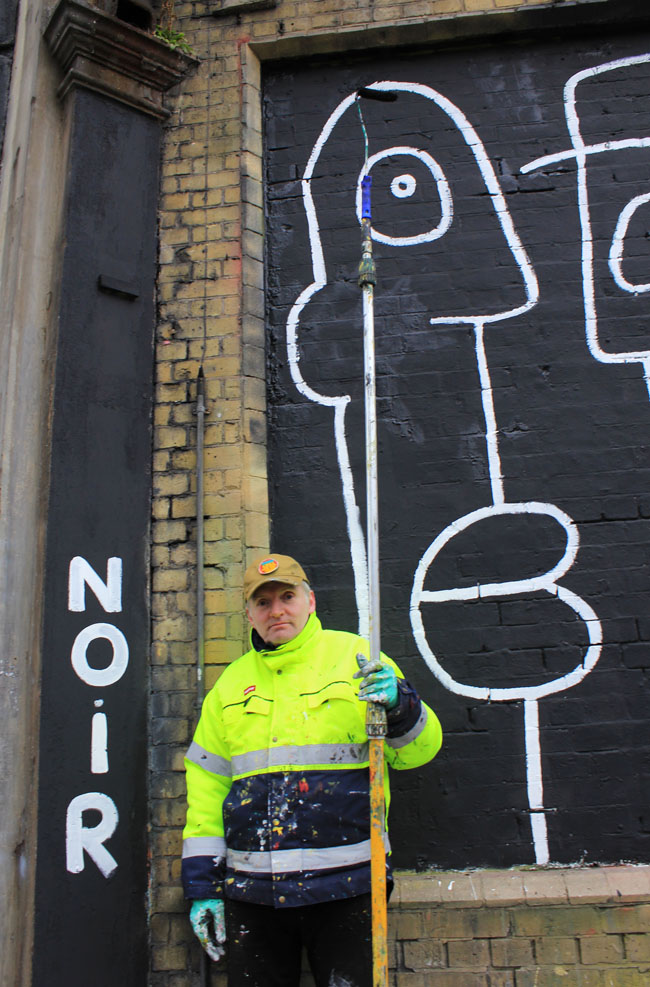
Noir at the end of his visit to London
Do you see yourself as a forerunner to contemporary street art? Do you think of yourself as part of that scene or separate from it?
Yes, I am a part of this scene, of course.
What do you think of the London street art scene?
I don’t know very much because this is my first time here in 20 years!
How do you think street art fits into the wider context of contemporary art?
Street art is coming into galleries more and more; it’s great. I saw today in the newspaper that Banksy’s wall sold for £500,000 – some piece of concrete from the street. This shows that there is a lot of value behind this street art. Galleries see that you can make money with it, and they run after you and ask you to make a vernissage… it’s impossible to stop it I think.

Just great ! See you soon, Thierry.
Regards.
Michel S.
Doing a research task and wanted to find out who took the interview with Thierry Noir to get some added information.